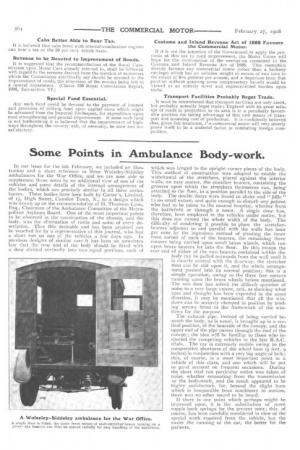Some Points in Ambulance Body-work.
Page 24

If you've noticed an error in this article please click here to report it so we can fix it.
In our issue for the 6th February, we included an illustration and a short reference to three Wolseley-Siddeley ambulances for the War Office, and we are now able to supplement those notes by an additional view of one of the vehicles and some details of the internal arrangement of the bodies, which are precisely similar in all three ambulances. These bodies have been built by Carter's, Limited, of is, High Street, Camden Town, N., to a design which was drawn up on the recommendation of H. Thomson Lyon, Esq., Chairman of the Ambulance Committee of the Metropolitan Asylums Board. One of the most important points to be observed in the construction of the chassis, and the body, was the elimination of rattle and noise of every description. That this desirable end has been attained can be vouched for by a representative of this journal, who had a short run on one of the vehicles a few days ago. In previous designs of similar cars it has been an unwritten law that the rear end of the body should be fitted with a door divided vertically into two equal portions, each of which was hinged to the upright corner pieces of the body. This method of construction was adopted to enable the withdrawal of the stretchers, placed against the interior walls, an easy matter, the stretcher bearers, containing the grooves upon which the stretchers themselves run, being attached to the floor, in a position parallel to the side of the body. The double doors were found to shake and "jiffle" t3 no small extent, and quite enough to disturb any patient who had to be taken to the nearest hospital, whether from the battlefield or through a town. A single door has, therefore, been employed in the vehicles under notice, but this does not extend the whole width of the body. The difficulty of rendering it possible to place the stretcherbearers adjacent to and parallel with the walls has been got over by the ingenious method of pivoting the inner front corner of each of the bearers, the remaining three corners being carried upon small brass wheels, which run upon brass bearers let into the floor. By this means the rear end of either of the two bearers contained within the body can be pulled outwards from the wall until it is exactly central with the doorway, the stretcher then can be slid upon it, and the whole arrange ment pushed into its normal position ; this is a simple operation, owing to the three free corners running upon the brass wheels before mentioned.
The one door has solved the difficult question of noise to a very large extent, and, as showing what care and thought has been expended in the sante direction, it may be mentioned that all the windows can be securely clamped in position by binding screws fitted to the framework of the windows for the purpose.
The exhaust pipe, instead of being carried beneath the body, as is usual, is brought up in a ver tical position, at the nearside of the canopy, and the upper end of the pipe passes through the roof of the canopy; the idea will be familiar to those who in spected the competing vehicles in the late R.A.C. trials. The car is extremely mobile owing to the comparative shortness of the wheel base (g feet, inches) in conjunction with a very big angle of lock ; this, of course, is a most important point in a vehicle of this class, and one which will be put to go')d account on frequent occasions. During the short trial run particular notice was taken of noise, whether emanating from the transmission or the body-work, and the result appeared to be highly satisfactory, for, beyond the slight hum which is inseparable from machinery in motion, there was no other sound to be heard.
If there is one point which perhaps might be improved upon, it is the substitution of more
supple back springs for the present ones; this, of course, has been carefully considered in view of the special work required from the vehicle, but the easier the running of the car, the better for the patients.




























